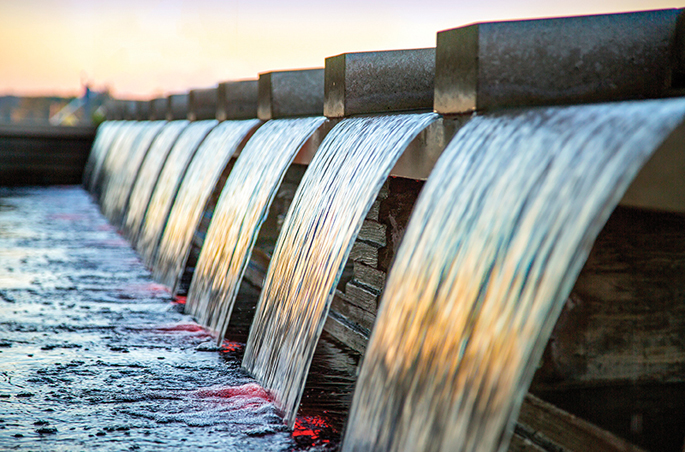
“I’d put my money on the sun and solar energy. What a source of power! I hope we don’t have to wait until oil and coal run out before we tackle that.”
-Thomas Edison, 1931
Over the millennia, the sun has provided us with the resources to live and exist. For example, photosynthesis helps plants grow for our own sustenance and for our livestock to eat. Our bodies use sunlight to create essential vitamins like vitamin D. We even use sunlight to sterilize water to make it potable for consumption.
Water is obviously another essential resource for survival. Now, thanks to the teaming of both water and sunlight, these two crucial resources are also creating efficient opportunities for water movement in various applications, such as aeration, pond management and agricultural watering.
New Cost Savings
Previously, creating beautiful water features required the use of electricity. The use of electrical wire or service can be prohibitively expensive in remote locations like the 16th hole of a golf course a mile from the nearest outlet, or the community of ranchettes on the edge of town. The average installed cost for a half mile of single-phase wire service is roughly $15,000, with three-phase service costing more than twice that. In addition, the annual maintenance fees associated with that service are above and beyond the monthly usage charges from the local utility.
Solar panels, now having been around for decades, are changing the landscape altogether. As with most technology, the cost of solar panels continues to decrease while the efficiency is increasing. The purchase cost is now less than 69 cents per watt, compared to a high of nearly $200 per watt in some areas in the 1970s. The panels are more efficient, now creating more power with the same area of space. Structurally, they are better. The days of fragile glass solar panels are ending and are being replaced with new materials that withstand our environment and weather much better. All common solar cells start as silicone (atomic No. 14 on the periodic table), which is a nonmetal with conductive super properties that provide the ability to convert sunlight into electricity. From there, the panels and their enclosures vary by manufacturer and use. Today, mono-crystalline panels are the most efficient, and amorphous thin film panels are the most flexible.
Applications Abound
The water pumping market has seen this positive trend and is taking hold of the newest technologies. Many ranchers and farmers are shying away from the expensive electrical systems for local source power, instead choosing the power of sunlight to water their livestock and enable agriculture to thrive even in remote areas. With a quick regular dusting of the panels, they always have the power they need.

Pond and lake management is another segment that is beginning to utilize solar rays to power aeration and fountain systems. Municipalities have begun to change over their floating aeration and fountain systems to solar and are experiencing significant monthly utility savings. Golf courses are adding new systems to their properties to improve aesthetics, especially during the harsh times of year for water features — early spring and the hottest parts of summer. Maintenance has improved as well with field-repairable drives like the Fhoton solar controller. All you need to install and modify the system is a six-in-one screwdriver. From irrigation pumps to lake management aeration systems, we are beginning to see solar systems utilized more for cost savings and convenience.
Worldwide Initiative
A major global impact is being made in communities with residents who formerly had to hike miles a day to gather water or relied on old technology like diesel-engine pumps prone to noise, pollution and breakdown. In Africa, for example, children walk 7 miles a day on average to access clean water. With solar pumping systems in place, they can now focus their extra time and peaceful environment on education, family, farming and community building.
The Franklin Wells for the World Foundation (FWWF) continues to make a difference in Africa by providing clean, safe drinking water through the installation of wells and leveraging Franklin Electric’s innovative products. Over the past six years, the FWWF has made a difference in the lives of more than 100,000 people. Last year, five projects spanning five different countries in Africa were completed, reaching nearly 18,000 people.
Energy Storage

The next solar-pumping evolution is focused on storage options. Currently, most solar technologies utilize the sun during the day to store the water in tanks for use after dark. Once the sun goes down, the pump turns off. Storing electricity for night use is a real option now as battery technology continues to improve. Recently, plans to build the largest battery in the world were announced, a 100-megawatt emergency backup battery for the electrical grid in South Australia. Lithium-ion batteries have been in widespread use since about 1991, but mostly on a small scale. A typical lithium-ion battery can store 150 watt-hours of electricity in 1 kilogram of battery, achieving more than double the capacity of nickel batteries. These projects are proving the large-scale use of battery storage and ensuring power delivery around the clock.
The recent total solar eclipse in North America reminded us of our dependence on and fascination of the sun. It is predicted that new solar installations will be less expensive than coal-based thermal power plants in most of the world within the next decade. By replacing fossil fuels with technology, we achieve a cost-effective balance of creating energy to manage our water needs. The sunlight we see is eight minutes old by the time it arrives, proving that the past continues to power the future.
>> For more information on energy storage, visit Energy Sage.


